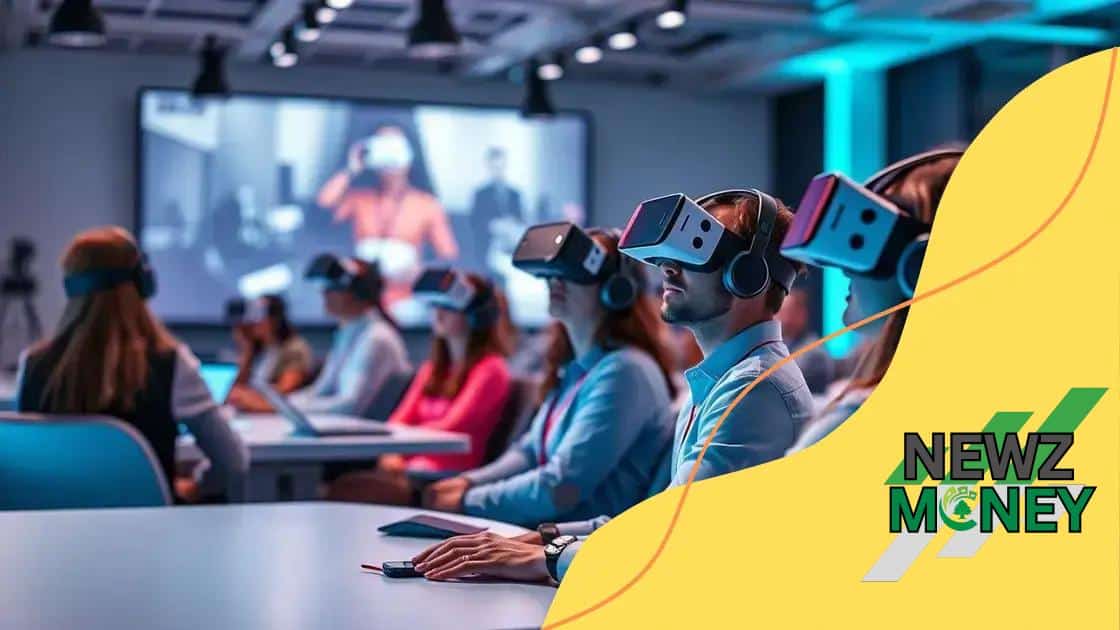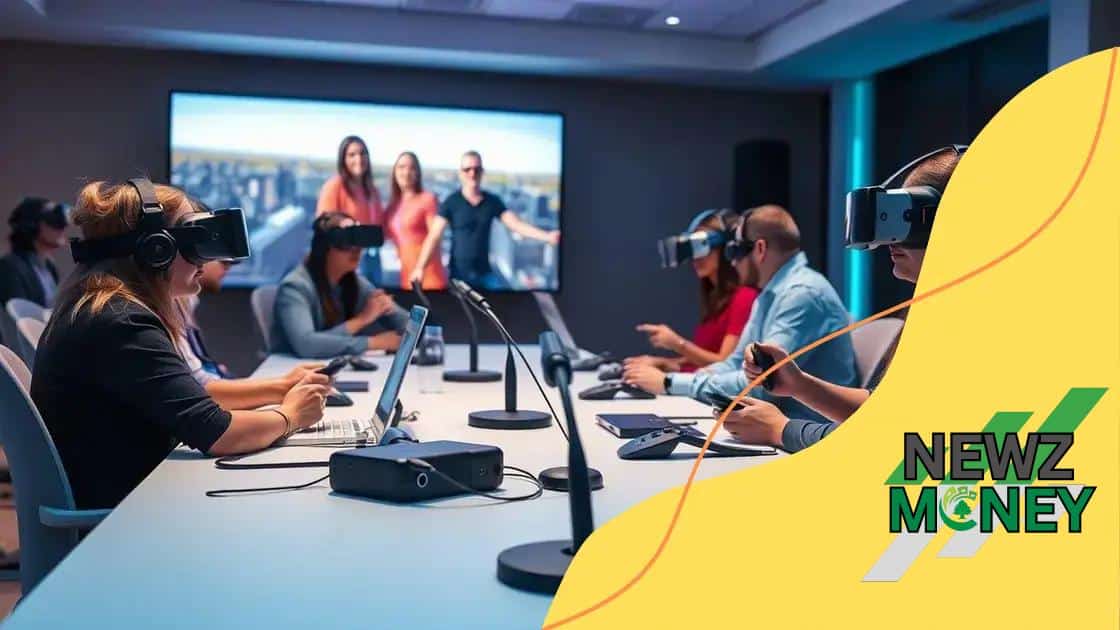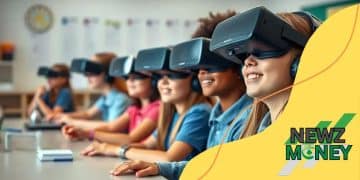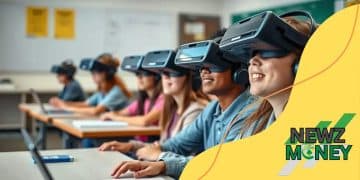Virtual reality for virtual conferences and events

Virtual reality for virtual conferences and events enhances engagement and learning by providing immersive experiences, fostering interactivity, and breaking geographical barriers for participants across various industries.
Virtual reality for virtual conferences and events is changing how we connect and collaborate. Have you ever considered how immersive experiences could enhance your next event? Let’s dive into this innovative approach.
Understanding virtual reality technology
Understanding virtual reality technology can seem daunting at first, but it’s quite fascinating. This technology creates immersive experiences that can transform how we interact in virtual events. In essence, virtual reality (VR) allows users to feel as if they are somewhere else, often using a headset that tracks their movements.
How Virtual Reality Works
Virtual reality technology uses a combination of hardware and software to create simulated environments. Here are key elements that make it work:
- Headsets: Wearable devices that display 3D visuals and track head movement.
- Sensors: Devices that monitor the user’s movements and allow interaction within the VR environment.
- Software: Programs that generate the visual and auditory elements of the virtual experience.
When you wear a VR headset, the imagery changes as you move your head, making it feel as if you’re truly inside that environment. This immersive experience can captivate any audience, making it perfect for virtual conferences.
Benefits of Using VR Technology
Utilizing virtual reality for events offers numerous advantages. Here are some key benefits:
- Enhanced Engagement: Participants feel more involved and attentive.
- Realistic Simulations: Attendees can experience situations as if they were real.
- Location Independence: People from anywhere can join without travel expenses.
This means that the power of VR is not just about visuals; it’s about creating connections and experiences that matter.
As technology continues to advance, the potential for VR in conferences and events only grows. Imagine hosting a global conference where every attendee feels present and engaged, no matter their location. That’s the future of events with virtual reality.
Benefits of virtual reality in events
The benefits of virtual reality in events are numerous and impactful. By leveraging VR technology, event organizers can create experiences that captivate audiences in ways traditional methods cannot. This leads to higher engagement and satisfaction levels among attendees.
Increased Engagement
One of the primary advantages of VR is enhanced engagement. With immersive environments, participants feel as if they are truly part of the event. They can interact with the surroundings, which keeps their attention focused.
- Participants can explore virtual spaces actively.
- Interactive elements make learning more effective.
- Engagement leads to higher retention of information.
This immersive quality not only entertains but also educates, making information stick. When people feel engaged, they’re more likely to participate actively.
Cost Efficiency
Using virtual reality can also be cost-effective. While initial setup might seem pricey, consider the savings in travel and venue costs. Many attendees can join from anywhere in the world, which cuts down on expenses significantly.
- No need for physical venues for all attendees.
- Reduced travel costs for participants and speakers.
- Environmentally friendly by limiting carbon footprint.
In addition, a well-designed VR experience can often replace multiple in-person events, maximizing the value of the investment.
Networking Opportunities
Networking is a crucial part of events, and VR offers unique ways to connect. Attendees can mingle in virtual spaces as if they were together in person. This breaks down geographical barriers and allows for diverse interactions.
- Virtual lounges and meeting areas facilitate conversation.
- Participants can engage with others who share similar interests.
- Enhanced networking boosts collaboration opportunities.
Ultimately, this fosters a sense of community among participants, which is essential for successful events.
Key tools for virtual reality conferences

When planning virtual reality conferences, it’s essential to choose the right tools. The right technology can significantly enhance the experience for both attendees and organizers. With the rapidly growing VR landscape, several key tools stand out as vital for successful conferences.
Hardware Essentials
First, let’s discuss hardware. The devices used can make a big difference in how immersive the experience feels. Key hardware tools include:
- VR Headsets: Devices like Oculus Quest and HTC Vive allow users to enter virtual environments.
- Controllers: Handheld devices that track movements and actions in the virtual space.
- High-Performance PCs: Essential for running complex VR applications smoothly.
Using quality hardware ensures a seamless experience that minimizes lag and enhances immersion.
Software Platforms
On the software side, platforms designed for virtual conferences are crucial. These platforms provide the framework for creating engaging experiences. Some notable platforms include:
- AltspaceVR: A social VR platform that supports events and networking.
- VRChat: Offers customizable environments for social interaction.
- Spatial: A collaboration-focused platform that brings teams together in virtual workspaces.
Choosing the right software platform helps to facilitate interaction and keep the audience engaged throughout the event.
Integration and Support Tools
Additionally, integrating various tools can enhance the event experience. Consider using:
- Video Conferencing Tools: Integrations with Zoom or Microsoft Teams can bridge the gap for non-VR participants.
- Live Streaming Services: Broadcast VR content to a wider audience who may not participate in VR.
- Analytics Tools: These help track participation and engagement levels during the event.
Effective integration of these tools allows for a more comprehensive and accessible event.
By carefully selecting and integrating these key tools, organizers can create enriching experiences that leverage the full potential of virtual reality for conferences.
Best practices for organizing VR events
Organizing a successful VR event requires careful planning and execution. There are several best practices that can enhance the experience for both organizers and participants. By following these guidelines, you can create a memorable event that attracts and engages a wide audience.
Define Clear Objectives
Before diving into the details, it’s important to define your event’s goals. Ask yourself what you want to achieve with your VR event. This clarity will guide your planning and help tailor the experience to meet those objectives.
- Audience Engagement: Decide how you want to interact with participants throughout the event.
- Content Delivery: Choose formats that resonate with your objectives, whether workshops, panels, or networking sessions.
- Feedback Collection: Consider how you will gather feedback to assess the event’s success and areas for improvement.
Having clear objectives allows your team to stay focused and organized as you move forward.
Choose the Right Technology
Selecting the right technology is crucial for a seamless experience. Not all VR platforms are created equal, and your choice can greatly impact the effectiveness of your event.
- VR Platforms: Opt for platforms that provide the necessary tools for interaction, such as AltspaceVR or Spatial.
- Interactivity Features: Ensure that your technology allows for participant engagement through chats, polls, and Q&A sessions.
- Technical Support: Have a technical team in place during the event to assist with any issues that may arise.
This attention to technology ensures participants have a smooth and enjoyable experience.
Promote Collaboration and Networking
A significant advantage of VR events is their ability to foster connections among participants. Encourage networking opportunities to make the event more interactive.
- Virtual Lounges: Set up spaces where attendees can mingle and exchange ideas.
- Scheduled Breakout Sessions: Create smaller groups for focused discussions.
- Interactive Activities: Introduce games or challenges that require teamwork.
This collaborative atmosphere helps build community and makes the event more enjoyable for everyone involved.
By implementing these best practices for organizing VR events, you can create a successful and engaging experience that resonates with participants, ultimately driving your objectives forward.
Case studies of successful VR implementations
Examining case studies of successful VR implementations provides valuable insights into how organizations can effectively use virtual reality. These examples show the versatility of VR across various industries and highlight best practices that can inspire future projects.
Healthcare Innovations
In the healthcare sector, VR has made significant strides. Hospitals and clinics are utilizing VR for training and patient treatment. For instance, programs that simulate surgeries allow medical students to practice in a risk-free environment. This enhances their skills before performing actual procedures.
- Training Simulations: Surgeons can practice techniques with realistic scenarios.
- Patient Therapy: VR is being used to help patients overcome phobias and anxiety disorders.
- Pain Management: Immersive experiences distract patients from pain during treatments.
These applications demonstrate the potential of VR to transform healthcare practices.
Education and Training
Educational institutions have embraced VR to create immersive learning experiences. One notable case is a school that implemented VR field trips. Students can explore ancient civilizations or distant planets without leaving the classroom. This method makes learning engaging and interactive.
- Virtual Field Trips: Students can visit locations all over the world.
- Interactive Lessons: Subjects like history and science come alive through visualization.
- Skill Development: Students gain hands-on experience in a controlled setting.
Such innovations enhance student engagement and comprehension by providing unique learning opportunities.
Corporate Training Examples
Businesses are also leveraging VR for corporate training. A well-known company implemented VR to train employees on safety protocols. By immersing workers in simulated hazardous environments, they could practice responses to emergencies without real-world risks.
- Enhanced Safety Training: Employees navigate dangerous scenarios safely.
- Cost Efficiency: Reduces the need for physical training resources.
- Team Building: VR can create scenarios that require teamwork.
These training sessions not only improve knowledge retention but also prepare employees for unexpected situations.
Through these case studies, we see how various industries successfully utilize VR technology. Whether in healthcare, education, or corporate training, the potential for innovative applications continues to grow.
virtual reality is revolutionizing how we engage in events. The case studies discussed highlight its versatility across industries like healthcare, education, and corporate training. By investing in the right technology and following best practices, organizations can create unforgettable experiences. As VR technology continues to evolve, the future of virtual events looks bright and full of potential.
FAQ – Frequently Asked Questions about Virtual Reality for Conferences and Events
What industries benefit the most from virtual reality events?
Industries such as healthcare, education, and corporate training are leveraging virtual reality to enhance engagement and learning experiences.
How does virtual reality improve audience engagement at events?
Virtual reality provides immersive experiences that capture participants’ attention, making them feel more involved and connected.
What are some key tools needed for organizing a successful VR event?
Essential tools include VR headsets, compatible software platforms, and support for interactive features that facilitate user engagement.
Can I reach a broader audience with virtual reality events?
Yes, virtual reality allows remote participants to join events without geographical limitations, increasing overall accessibility and attendance.





